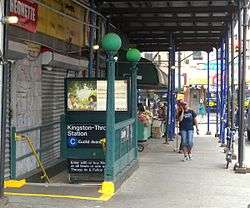Kingston–Throop Avenues (IND Fulton Street Line)
Kingston–Throop Avenues | |||||||||
|---|---|---|---|---|---|---|---|---|---|
|
| |||||||||
|
| |||||||||
| Station statistics | |||||||||
| Address |
Fulton Street between Kingston Avenue & Throop Avenue Brooklyn, NY 11216 | ||||||||
| Borough | Brooklyn | ||||||||
| Locale | Bedford-Stuyvesant, Brooklyn | ||||||||
| Coordinates | 40°40′47″N 73°56′26″W / 40.679857°N 73.940606°WCoordinates: 40°40′47″N 73°56′26″W / 40.679857°N 73.940606°W | ||||||||
| Division | B (IND) | ||||||||
| Line | IND Fulton Street Line | ||||||||
| Services |
A C | ||||||||
| Transit connections |
| ||||||||
| Structure | Underground | ||||||||
| Platforms | 2 side platforms | ||||||||
| Tracks | 4 | ||||||||
| Other information | |||||||||
| Opened | April 9, 1936[1] | ||||||||
| Station code | 180[2] | ||||||||
| Wireless service |
| ||||||||
| Traffic | |||||||||
| Passengers (2017) |
2,085,536[4] | ||||||||
| Rank | 237 out of 425 | ||||||||
| Station succession | |||||||||
| Next north |
Nostrand Avenue: A | ||||||||
| Next south |
Utica Avenue: A | ||||||||
| |||||||||
| |||||||||
| |||||||||
Kingston–Throop Avenues is a local station on the IND Fulton Street Line of the New York City Subway. Located on Fulton Street between Kingston and Throop Avenues in Bedford-Stuyvesant, Brooklyn, it is served by the C train at all times except nights, when the A train takes over service.
Station layout
| G | Street level | Exit/entrance |
| M | Mezzanine | Fare control, station agent, MetroCard machines |
| P Platform level |
Side platform, doors will open on the right | |
| Northbound local | ← | |
| Northbound express | ← | |
| Southbound express | → | |
| Southbound local | | |
| Side platform, doors will open on the right | ||

This underground station, opened on April 9, 1936,[1] has four tracks and two noticeably offset side platforms, with the southbound platform located roughly 300 feet further west (railroad north) than the northbound platform. The two center tracks are used by the A express train during daytime hours. The platforms have name tiles that read "KINGSTON - THROOP AV." in white sans serif lettering on two lines on a dark yellow background with a yellow trim line. Beneath the name tiles are small black station signs directing riders to either "KINGSTON" or "THROOP" Avenues in white lettering. The platforms are columnless except for a few dark yellow I-beam ones near fare control.
Under the 2015–2019 MTA Capital Plan, the station, along with thirty other New York City Subway stations, will undergo a complete overhaul and would be entirely closed for up to 6 months. Updates would include cellular service, Wi-Fi, charging stations, improved signage, and improved station lighting.[5][6][7] However, these renovations are being deferred until the 2020–2024 Capital Program due to a lack of funding.[8]
Exits
Each platform has one same-level fare control area. The one on the Euclid Avenue- and Queens-bound platform is at the extreme west (railroad north) end and has a bank of three turnstiles, and one staircase going up to the southeast corner of Fulton Street and Kingston Avenue. The one on the Manhattan-bound platform is at the center and has a bank of four turnstiles, a full-time token booth, and two staircases going up to either northern corners of Fulton Street and Throop Avenue.[9]
1995 token booth murder
This station was the site of a 1995 robbery that killed the token booth clerk, 50-year-old Harry Kaufman. Robbers squirted accelerant into the booth on the Euclid Avenue-bound platform and set the fumes alight with a match, causing an explosion that blew out the glass and deformed the booth. The incident drew national attention due to allegations that the movie Money Train (1995) inspired the murder. The allegations were unfounded and the movie's producer, Columbia Pictures, claimed that the scenes were inspired by an earlier event, in 1988, where another token booth clerk was killed in the same fashion.[10][11][12]
Nearby points of interest
- Brooklyn Children's Museum — 0.8 miles away
- Restoration Plaza — 0.3 miles away
References
- 1 2 "NEW SUBWAY LINK OPENED BY MAYOR; He Tells 15,000 in Brooklyn It Will Be Extended to Queens When Red Tape Is Cut". The New York Times. 1936-04-09. ISSN 0362-4331. Retrieved 2016-08-15.
- ↑ "Station Developers' Information". Metropolitan Transportation Authority. Retrieved June 13, 2017.
- ↑ "NYC Subway Wireless – Active Stations". Transit Wireless Wifi. Retrieved May 18, 2016.
- ↑ "Facts and Figures: Annual Subway Ridership 2012–2017". Metropolitan Transportation Authority. July 12, 2018. Retrieved July 12, 2018.
- ↑ "MTA Will Completely Close 30 Subway Stations For Months-Long "Revamp"". Gothamist. Archived from the original on 2016-08-01. Retrieved 2016-07-18.
- ↑ "MTAStations" (PDF). governor.ny.gov. Government of the State of New York. Retrieved 2016-07-18.
- ↑ "Review of the A and C Lines" (PDF). Metropolitan Transportation Authority. December 11, 2015. Retrieved 19 January 2016.
- ↑ Berger, Paul (2018-04-03). "New York Subway Cuts Back Plans to Renovate Stations". Wall Street Journal. ISSN 0099-9660. Retrieved 2018-04-03.
- ↑ "MTA Neighborhood Maps: Bedford-Stuyvesant" (PDF). Metropolitan Transportation Authority. 2016. Retrieved 5 July 2016.
- ↑ Holloway, Lynette (1995-12-16). "Token Booth Fire Attack Seems Unrelated To Movie". The New York Times. Retrieved 2010-05-07.
- ↑ Terry, Don (1988-06-05). "Subway Token Clerk Dies After Booth Was Set Afire". The New York Times. Retrieved 2010-05-07.
- ↑ Vandam, Jeff (2006-12-31). "Cash and Carry". The New York Times. Retrieved 2010-05-07.
External links

- nycsubway.org – IND Fulton: Kingston/Throop Aves
- Station Reporter — C Train
- The Subway Nut — Kingston–Throop Avenues Pictures
- Kingston Avenue entrance from Google Maps Street View
- Throop Avenue entrance from Google Maps Street View
- Platforms from Google Maps Street View



